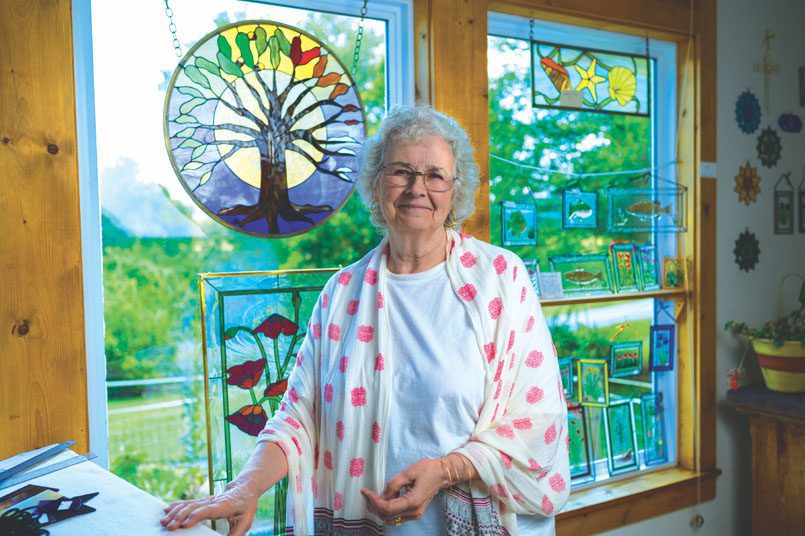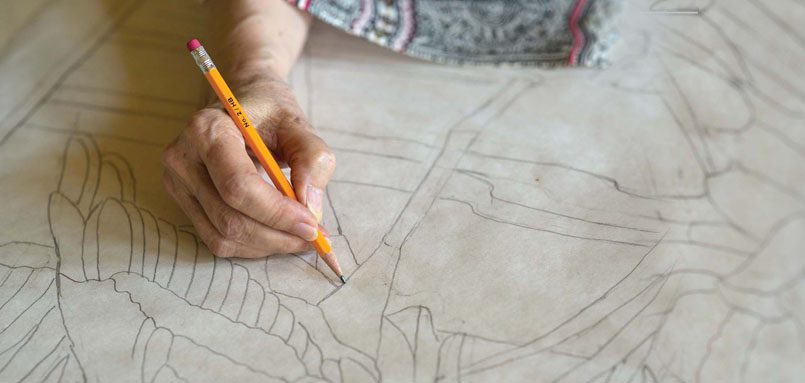31 Jul 2021 Celebrating Artistic Excellence: Roberta Katz-Messenger
By Aaron Brand
Roberta Katz-Messenger has applied her talent and an artist’s sensitivity to the stained-glass arts for the better part of four decades, but the pursuit still gives her plenty of renewed inspiration.
As an art form, stained glass forever changes. With its play of glass and light, it’s never static. There’s an element of surprise.

“It’s got a liveliness that continues to blow me away,” Roberta said. “I will finish something, and you can’t really tell what it’s going to look like until it’s done.”
Assuredly, she’s well-known in Clinton, Arkansas, where she ran Pentacle Gallery for 18 years, and where she and her husband, Steve, now run Katz-Messenger Stained Glass.
But her art is all over the state, perhaps in a cozy living room or inside the hushed chapel of an Arkansas church, resonating with the solemnity of spiritual feeling.
And there at Roberta’s studio in a countryside setting two miles outside of Clinton, projects include stained glass for a variety of places: churches, homes, public spaces and more. Plus, she creates artistic objects like lamps and panels.
Roberta’s art beautifies, among many places of worship: Holy Trinity Episcopal Church, St. Jude’s Catholic Church, South Side Baptist Church, and Peace Lutheran Church. Whether the church is Baptist, Unitarian, or some other denomination under the sun, Roberta captures the essence of a spiritual message parishioners aim to convey through stained glass when lit by light.
Residential work often favors natural themes: sunflowers, a waterfowl triptych, or a secret garden. She’ll make transom panels and a Victorian window.
Camp Aldersgate in Little Rock, which serves people with disabilities, features her theme window work with canoeing and a campfire, even a raccoon and a four-seasons tree. Her work “Healing Waters” at Ozark Health Medical Center connects nature to restorative powers.
She’s versatile, but the work is always captivating with the details and color.
Roberta’s job is mainly design, pattern drawing, cutting, and wrestling with the paperwork. They primarily do copper foil stained glass (easier with small pieces), unless lead seems like a better idea. Her husband helps with job aspects like foiling and soldering.
“He’s actually more than the installer. He does a lot of the construction and occasionally pattern drawing and a lot of the installation,” Roberta said, adding, “I usually do the finishing.”
While she ran Pentacle Gallery, she showcased Arkansas artists and craftspeople. The public gave her a loyal following. Artists she carried included William McNamara.
“I was so lucky at that time because there wasn’t very many people who were handling strictly fine crafts,” Roberta recalled about working with Natural State artisans.
She was right on the highway with a yellow house and interesting things to see in the yard – even, one Christmas season, a camel to give rides. It attracted attention.
“There was a lot of help from everybody,” Roberta recalled about the community spirit that helped her gallery along. In this sense, she fostered a community of artist contacts and cohorts.

Roberta grew up in the Chicago area (South Side) and learned about art at the Art Institute of Chicago. She studied at the Goodman School of Drama and worked at the University of Chicago (public relations, conference coordinator) and other interesting jobs before heading west.
In Denver, Roberta was introduced to stained glass in a roundabout way (she apprenticed with Rhonda Dixon), and thus her long, fruitful journey with the art form began. While there, still in her 20s, she worked as a dinner theater singer.
But back when she was in Chicago, she recalls she felt a life-changing realization when Martin Luther King Jr. was assassinated. She was shaken.
“I decided to go be what I wanted to be and stop worrying about trying to make everybody else come to understand what I hoped they would understand,” Roberta said.
To that end, she and her Denver friends wanted to be part of the “back-to-the-land” movement.
Longing to put their ideals into practice, they moved to Clinton in the early 1970s, where she soon started her gallery. And with her friends, she enjoyed a vast stretch of acreage in the woods to call home.
“Believe it or not, some of the town city fathers here immediately seemed to take a shine to stained glass, and I wound up with jobs right away,” Roberta recalled. She kept at it. Sometimes she can drive through town and see the first stained glass she made. What was it about the art form she appreciated? Why did she take a shine to it so many years ago?
“It’s so changeable. You look at it one day with the sun at one altitude and it looks like one thing, and then it just shifts so much. Then, too, the fact that it’s luminous. Painting with light is one of the phrases that one hears often, and that’s kind of how it is,” Roberta said.
Roberta recalled first doing stained glass for a church, her favorite in town, a challenge she finally welcomed.
“That’s been another layer of meaning, of design difficulty, because you’ve got to walk into somebody’s sacred place, listen very carefully to everything that you’re told and everything you see, and all the elements that are already there,” Roberta said.
She’s mindful of what she must do: create something inspirational. Stained glass inside a church conveys a message that means something deep to the people within.
“That kind of responsibility is kind of mind-boggling, but I love that because it’s such a service to them to tell the story in stained glass in a way that’s going to persist, it could be, a very, very long time,” Roberta said.
To learn more about Roberta Katz-Messenger’s art and studio visit kmstainedglass.com.








